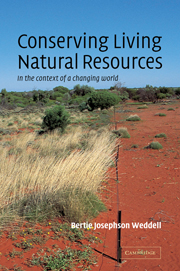Book contents
- Frontmatter
- Contents
- Preface
- Introduction: Balance and flux
- Methodology: Getting the information we need to manage living natural resources
- Part I Management to maximize production of featured species – a utilitarian approach to conservation
- 1 Historical context – the commodification of resources and the foundations of utilitarian resource management
- 2 Central concepts – population growth and interactions between populations
- 3 Central concepts – habitats
- 4 Techniques – harvest management
- 5 Techniques – habitat management
- 6 Techniques – management to minimize conflicts between pest species and people
- Part II Protection and restoration of populations and habitats – a preservationist approach to conservation
- Part III Management to maintain processes and structures – a sustainable-ecosystem approach to conservation
- Postscript
- Appendix: Scientific names of organisms mentioned in the text
- Index
2 - Central concepts – population growth and interactions between populations
Published online by Cambridge University Press: 05 June 2012
- Frontmatter
- Contents
- Preface
- Introduction: Balance and flux
- Methodology: Getting the information we need to manage living natural resources
- Part I Management to maximize production of featured species – a utilitarian approach to conservation
- 1 Historical context – the commodification of resources and the foundations of utilitarian resource management
- 2 Central concepts – population growth and interactions between populations
- 3 Central concepts – habitats
- 4 Techniques – harvest management
- 5 Techniques – habitat management
- 6 Techniques – management to minimize conflicts between pest species and people
- Part II Protection and restoration of populations and habitats – a preservationist approach to conservation
- Part III Management to maintain processes and structures – a sustainable-ecosystem approach to conservation
- Postscript
- Appendix: Scientific names of organisms mentioned in the text
- Index
Summary
In the previous chapter we saw how overexploitation of living renewable resources created a need for more rational management of wild plant and animal populations. In response to this situation, conservationists in the young disciplines of wildlife management, forestry, and range management adopted a utilitarian approach, which emphasized the economic values of species. Utilitarian managers seek to regulate the exploitation of economically valued plant and animal species and to minimize populations of species that are considered weeds or pests.
In this and the following chapter we will consider the central concepts underlying utilitarian management. This type of management focuses on certain phenomena in nature, including population regulation in resourcelimited systems, predation, the specific requirements of organisms of interest, and changes in community composition over time. The last three chapters in this section illustrate how this understanding of the natural world is applied by utilitarian managers.
Adding to and subtracting from populations
A population can be defined as a group of organisms of the same species occupying a defined area during a specific time. For example, we may want to refer to the population of people in Germany in 1910 or in 1999, the population of aphids on a rose bush, spruce trees in a forest, fish in a lake, or pronghorns in Wyoming.
The rate at which a population grows depends upon how many individuals are added to and removed from it during a given period of time.
- Type
- Chapter
- Information
- Conserving Living Natural ResourcesIn the Context of a Changing World, pp. 60 - 76Publisher: Cambridge University PressPrint publication year: 2002



